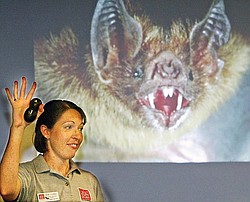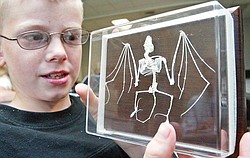Flying mammals benefit humans
Marne Titchenell, OSU Extension Wildlife Specialist, leads a program about bats Tuesday at the Trumbull Agriculture and Family Center in Cortland. A projected image of a bat is behind her.
Dylan Belski, 9, of Cortland, examines a bat skeleton during a Tuesday program about bats at Trumbull Agriculture and Family Education Center in Cortland.
By Ed Runyan
A bat’s wing is made up of fingers encased in a membrane, which gives them great maneuverability.
CORTLAND — Marne Titchenell, a wildlife specialist for the Ohio State University Extension Service, probably miscalculated the attitude of 18 children age 8 to 12 toward one of her favorite animal species: the bat.
To see whether her presentation had changed their attitude, she asked them before and after Tuesday to indicate how they feel about the small, flying creatures.
Before the presentation, 13 said they already liked bats, despite their scary reputation; one said he or she didn’t like them; and four said they didn’t know.
After, the four shifted from the “didn’t know” category to the “like” category. The “didn’t like” kept his or her opinion after the presentation, which focused on the good things bats do for humans, such as eating insects.
Titchenell said after her talk at the Trumbull County Agricultural Service Center that children that age generally already know that bats are useful to humans, having learned about them in school.
It’s the adults who more frequently have concerns about bats carrying rabies, getting into the attic and chasing people, she said.
For the record, less than 1 percent of bats have rabies, bats can live in the attic of a house without harming the humans, and bats have no desire to chase people, Titchenell said.
Titchenell gave her talk Tuesday as part of the Trumbull Soil and Water Conservation District watershed field school that continues today at the Agriculture and Family Education Center. The school provides children with hands-on activities and field trips to a local stream and wetland.
“When we are out at night we attract insects, so the bats dive-bomb around us for insects,” Titchenell said. “They have no interest in us.”
Titchenell, who studied bats for three years, said she has an affection for them. She regularly advises adults who want the mammals out of the attic to allow the animals to survive by using a device that allows them to exit the attic, but not return.
“Generally, I tell people if they’re not bothering you, by all means leave them,” she said.
“I didn’t know some of them were losing their homes,” said Andrzej Luckwitz, 9, of Braceville, referring to Titchenell’s remarks about how some Indiana bats are endangered.
Titchenell noted that it is still important to stay away from bats, because there is a chance they could bite and spread rabies. Their waste also can carry a fungus that could lead to illness in humans, she said.
She focused much of her talk with the children on the amazing maneuverability of a bat, which allows the small creatures to catch 600 to 800 insects in a single night — or roughly the equivalent of their own body weight.
The reason for their nimbleness is that their wings are made up of long fingers encased in a membrane.
Unlike birds, which have a fixed wing, bat wings are flexible, Titchenell said. That explains the bat’s sudden movements, she said.
Kayla Finnerty, 12, of Cortland, said she enjoyed learning about the long fingers inside a bat’s wing and learning that some bats have a wingspan of six feet.
Despite the reputation of bats for drinking blood, only vampire bats do that, and vampire bats only exist in south and Central America, she said.
And even then, the animals whose blood is being removed — generally cattle and pigs — don’t notice or suffer from the act, Titchenell said. Ohio bats only eat insects.
Bats help pollinate fruit such as bananas and mangoes, and bats are fairly clean animals. Because they fly, their wings have to be clean, she said.
Bats use echolocation — something similar to sonar — to help them locate insects, Titchenell said, but it is untrue that bats don’t see well.
runyan@vindy.com
Marne Titchenell, a wildlife specialist with the Ohio State University Extension Service, gave children some of the following facts on bats:
The biggest bats have a wing span of 6 feet; the smallest weigh the same as a U.S. dime.
Though mice and bats look similar, they are not considered closely related other than they are both mammals.
The technical name for a bat is chiro-ptera, which means hand-wing.
The most common type of bat in Ohio is a Little Brown Bat.
There are 11 species of bats in Ohio.
Bat excrement, known as guano, is high in nitrogen and is sometimes used to help plants grow.
 43
43


